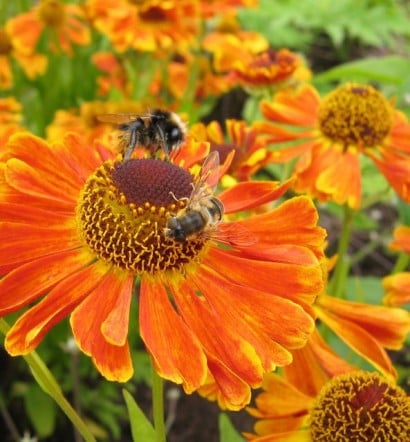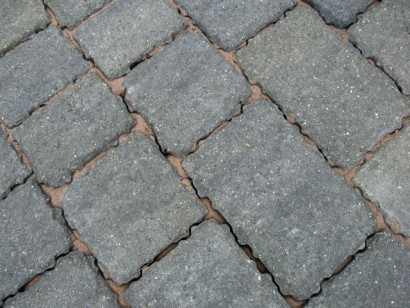If we made more of our gardens’ huge potential as the first line in flood defence, fewer of us might need to resort to sandbags next time round.
With thousands of homes flooded and their gardens submerged, there’s a hollow, ringing futility to recent gardening advice along the lines of ‘use a board to get onto waterlogged soil’ or ‘improve drainage by spiking your lawn with a fork’ (presumably from a dinghy). And just as the fiercest Atlantic storm yet whipped weather warnings to red, the best our garden industry could muster was a press release about how ‘well thought out plant displays can engage consumers’ senses and drive impulse purchasing’. Meanwhile, a conference on garden centre cafés brewed up its own trend-setting storm over – you guessed it – the sales of loose-leaf tea. As we get a shocking foretaste of what a changing climate and its new, volatile weather looks and feels like, gardening can surely do better than this.

When it needs to, gardening steps up to the plate. Take bees. Once the alarm bells sounded over the decline in bee populations, and the insidious effects of neonicotinoid garden bug-killers were exposed, some polluting ‘neonics’ were banned. Since then, bees have never had it so good: ‘perfect pollinator’ plant lists are a click away, and new products, from seed mixes to ‘bee mats’, abound. Naff bandwagon stuff apart, this has been a rare all-round win for gardeners, garden retailers and – crucially – nature. With the world around us becoming ever more mercurial, we need all the joint wins for ‘team gardening and nature’ (‘Team GN’?) we can get.
I’ve spotted a potential new win – for people, wildlife and planet – involving lots of flowers. It’s a win that will combine creativity with practicality, and bring knock-on, tangible benefits not just for our neighbours, but for society at large. I haven’t dreamt up some smart new idea to harness the gentle power of everyday gardening to help navigate our tempestuous new future; all I did was tap ‘rain garden’ into Google. I got over 150 million hits in 0.14 seconds (beating the 13 million-plus for ‘loose leaf tea’). The virtual world is chockablock with information on rain gardens, much of it solidly useful (the ‘Rain Garden Guide’ is a good UK primer). But while the web is replete with information, and whole books have been devoted to rain gardens, there’s precious little buzz about them – or about their winning potential.

A rain garden is one which simply reroutes rainwater, from a building roof or hard-surfaced area, so that instead of rushing off into the drains, it’s allowed to fulfil its destiny: soaking into the soil. Such gardens are limited only by your imagination, and by a few basic rules, like making them at least 3m (10ft) from buildings. A simple rain garden planter can be built near a downpipe, and filled with plants. Rain from the roof flows into the planter, slows down, and waters the plants. Once the planter is ‘full’, the rainwater can then flow out again, into a drain or a pond. Any pond overflow is then carried on a further journey by a rill or, even better, a wildlife-friendly, meandering shallow groove in the soil (technically known as a ‘swale’). Finally, the calmed water flows into the main rain garden area – a shallow, sculpted depression, typically saucer-shaped with raised outer ridge (or ‘berm’), planted with flowers that don’t mind getting their feet wet for short spells when the saucer’s full. There’s endless scope for imaginative combinations of the finest wild flowers with the cream of the cultivated. From the moment the rainwater hurtles from a downpipe, it’s being tamed and calmed before returning to the earth.
In the gardens most of us have at the moment, once our water butts are full, much of our ‘harvestable’ rainwater scurries off into the underground drainage network. Most of the time the drains can cope, but when we get the increasingly sudden, intense downpours that are being delivered by a changing climate, they can’t. Water that is denied its natural route into the soil, by watertight hard surfaces and impermeable lawns, causes flash flooding and all the misery, chaos and cost that comes with it. Celebrity gardeners recently claiming that they’re ‘not to blame’ for flooding might reflect that every millimetre of rain falling on a square metre of impervious surface produces a litre of water. And those suggesting that more lawns are the ‘answer’ to urban flooding problems might bear in mind research showing that soil planted with trees soaks up water 67 times faster than it does when it’s growing just grass. If space allows, trees can be an integral part of a rain garden.
All the flowers in the world won’t prevent the kind of flooding we’ve seen on the Somerset Levels, or along flood plains; the solutions here are complex, large-scale and involve rethinking land management way upstream. But in towns and cities, where most of us live, rain gardens filled with flowers offer a can-do, beautiful solution to a growing problem. We’re hearing more about Sustainable Drainage Systems (SUDS) in strategic urban planning, but little about home rain gardens out front or out back; they need to be in among the SUDS, too. As is so often the case, gardeners are prime targets for boosting sales of loose leaf tea, but get forgotten when it comes to the environmental good that our gardens, collectively, can achieve. And it’s no good waiting for another fad to come along; it’s faddism that gave us decking, which is now part of the problem. It’s time to ditch decking, prise up patio paving, cut up concrete and let go of lawns (except the muscle-mown ones). As our climate changes and challenges us, gardening must come of age.

Perhaps we can turn this around – by talking and by taxation. We need to be discussing and seeing more about rain gardens in all their shapes and forms. We need to make the knowledge and advice on how to create a simple rain garden available to all, not just to those who can afford a garden designer. These gardens can benefit our wider society by helping to reduce flooding, so they should be affordable and accessible to all. One simple way to roll out rain gardens would be to offer households free initial advice on their feasibility (not every garden is suitable), and a cash subsidy toward their planning, installation and planting. Water companies might even discount their bills where a measurable amount of rainwater goes into the soil, rather than into a drain (we can but dream).
But where would this flood-relieving fund come from? As decking, paving and lawns are among the chief culprits in divorcing rainwater from soil, why not put a ‘rain garden tax’ on them? This would have the double win of discouraging environmentally-unfriendly gardening, while encouraging the kind which brings positive benefits. Non-polluting, push-powered lawnmowers could benefit from tax relief, as could ‘permeable paving’ (but not the rain-repelling kind usually used for in-garden car parking spaces). A tax on powered lawn care equipment (more peace, less pollution), weedkillers, pesticides and fertilisers, as well as on slabs and decking, could help fund home rain gardens as well as larger-scale ones in our parks and public spaces, and could be extended to encourage the take-up of living ‘green roofs’. Is this sounding like another win for Team GN?
Encouraging gardening that’s fit for the 21st century, where growing flowers can help reduce the risk of flooding in our towns and cities, sounds to me like a good, winning formula. It’s certainly got a more positive ring to it than ‘use a board to get onto waterlogged soil’.
Text and images © John Walker. Storm image © NASA Earth Observatory


